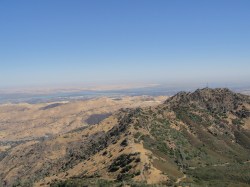This is part of a series exploring how collective intelligence can create a better world. Read the whole series here.
Picture this: You’re out on a hike in Mt. Diablo State Park, just outside San Francisco. Upon reaching a nice viewpoint, you think, “Hey, this would look pretty sweet on my Instagram feed.” So you whip out the ol’ iPhone to snap a selfie. Then you notice a sign with an L-shaped bracket next to it. The sign asks you to fit your phone into the frame, pointing your camera lens at the drab brown hill across the way, take a photo and upload it to Flickr, Twitter, or Instagram with the hashtag #morganfire01.
“Why would anyone want a picture of that?” you ask.
Turns out, it’s a project that was put together by Nerds for Nature, a group of civic hackers who do good for the Earth by connecting researchers, enviros, and tech whizzes to figure out new ways to protect our planet. The Mt. Diablo project is designed to monitor the area’s ecological recovery after it was toasted by a wildfire last September. Once you tag and upload the photos, researchers can easily compile them into a crowdsourced time-lapse series that will show the process of vegetation growing back. As wildfires become increasingly common with climate change, a project like this could help researchers determine the longer-term impacts these fires will have.
“We see people with their smartphones as a potential volunteer censor network in the park,” Nerds for Nature co-founder Dan Rademacher explains.
The Mt. Diablo fire recovery project is just one example of how the internet and tech enables a new kind of citizen science – science that’s done by non-professionals. Citizen science is by no means new, but over the last decade it has become popular enough that the Citizen Science Association, which was created last February, already has more than 1,400 members — people who are drawn in by the potential of citizen science to transform the way we look at research, and get the public involved in fresh new ways.
Part of citizen science’s growing popularity has to do with the ways in which tech has enabled scientists to tap into the potential of all of us — especially those of us running around with smartphones — as data collectors. There are now dozens of projects that allow people to contribute to science even as they go about their normal lives. Notice that the flowers in your neighborhood are blooming earlier this year? Send in a report via Neon’s project Budburst app to help researchers figure out whether that’s part of a broader trend. Are you a lifelong birder? Log your sightings in eBird and help ornithologists keep track of what bird populations are up to these days. Or, do you just want to zone out on the couch for an evening? Search through SciStarter or Zooniverse and you’ll find plenty of ways to contribute from the comfort of your own home, by categorizing images or even playing games.
Ornithologist Caren Cooper explains that one of the advantages of citizen science is that it’s an easy way to collect data that is spread out through both space and time. “There are questions that I could not answer without participation from the public,” Cooper says. “These are questions on exceedingly large scales — like latitudinal gradients, across urbanization gradients — things that require a massive number of study sites.”
But this isn’t solely about tapping in to the extra manpower. There are simpler ways to take pictures of a burnt landscape, for example; just install one camera and program it to take a picture at specific intervals. But citizen science enthusiasts believe that getting more people involved also adds value to the participants’ lives, and helps them feel more involved in the cause. It makes people feel like science isn’t just this kind of remote thing done by people in white coats in labs, but something rather more approachable.
“What excites me the most is the opportunities to include individuals in their own learning, through exploration, through going out and making observations or measures of the world around them,” Sandra Henderson, vice-chair of the Citizen Science Association, says. “You can have an education and outreach project, but at the same time be collecting useful data — that’s the beauty of it.”
And, when it comes to mobile technology, Henderson says she gets the most jazzed when she sees it in the hands of a younger and more diverse crowd than has historically participated in citizen science. “It’s a way to reach a much broader audience.”
Citizen science is also changing how scientists conceive of what they do: “There has been this trend toward more collaborative work, and a recognition that the problems we’re facing today can’t be solved within the silos that have traditionally been associated with scientific practices,” Jennifer Shirk, who studies the practice of citizen science, says. While scientists have traditionally preferred to do their work in their own, protective bubble, where they can guarantee that it’s objective and unbiased, Shirk says citizen science can still yield quality results while also allowing researchers to embed what they do within the social context of conservation.
As for what’s going on over at Mt. Diablo, it’s unclear whether it will yield a paper a scientific journal. But Nerds for Nature has compiled the photos on its website, available for anyone to look at. And there are a lot of them, which begs the question: When you’re suddenly able to reel so much data in, how do you process it?
That’s something to keep in mind for my next story, about a project that uses distributed computing to help scientists crunch the numbers on how we’re going to be affected by future climate change.





